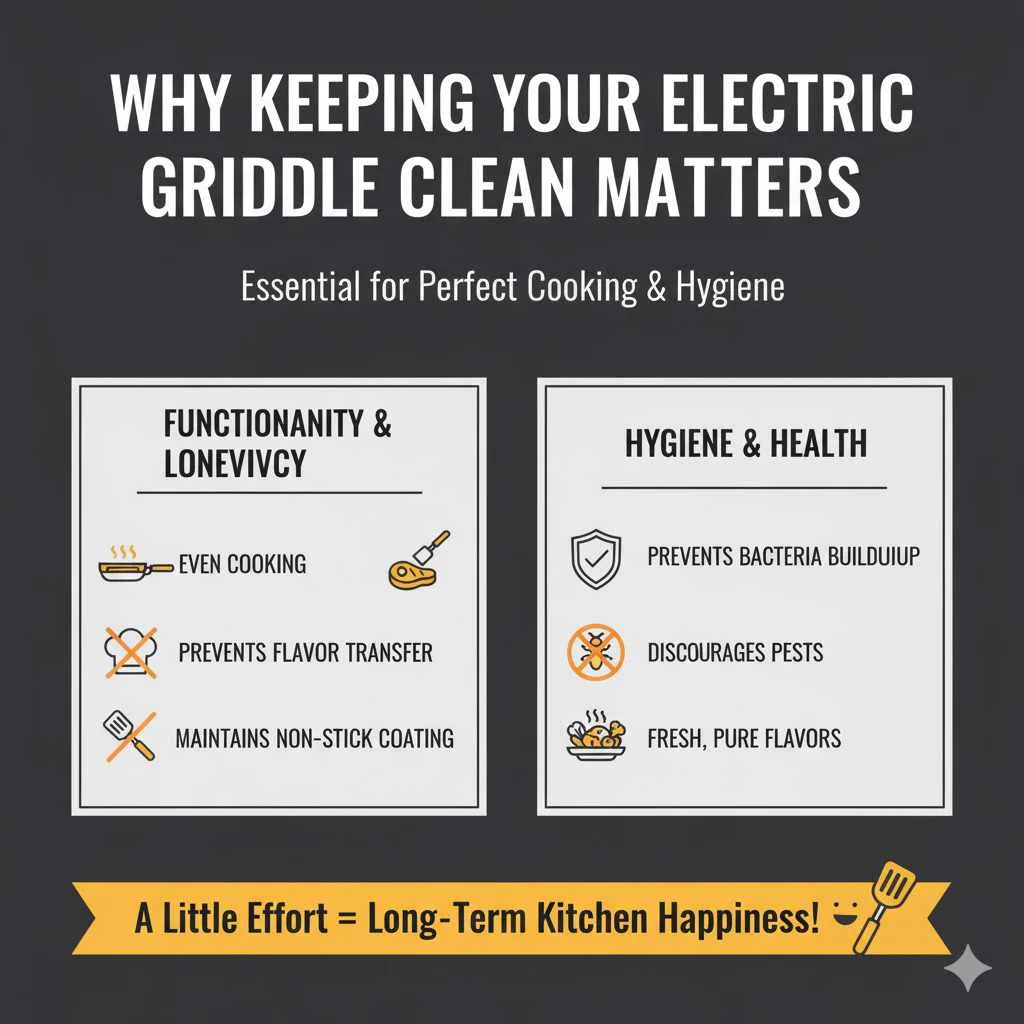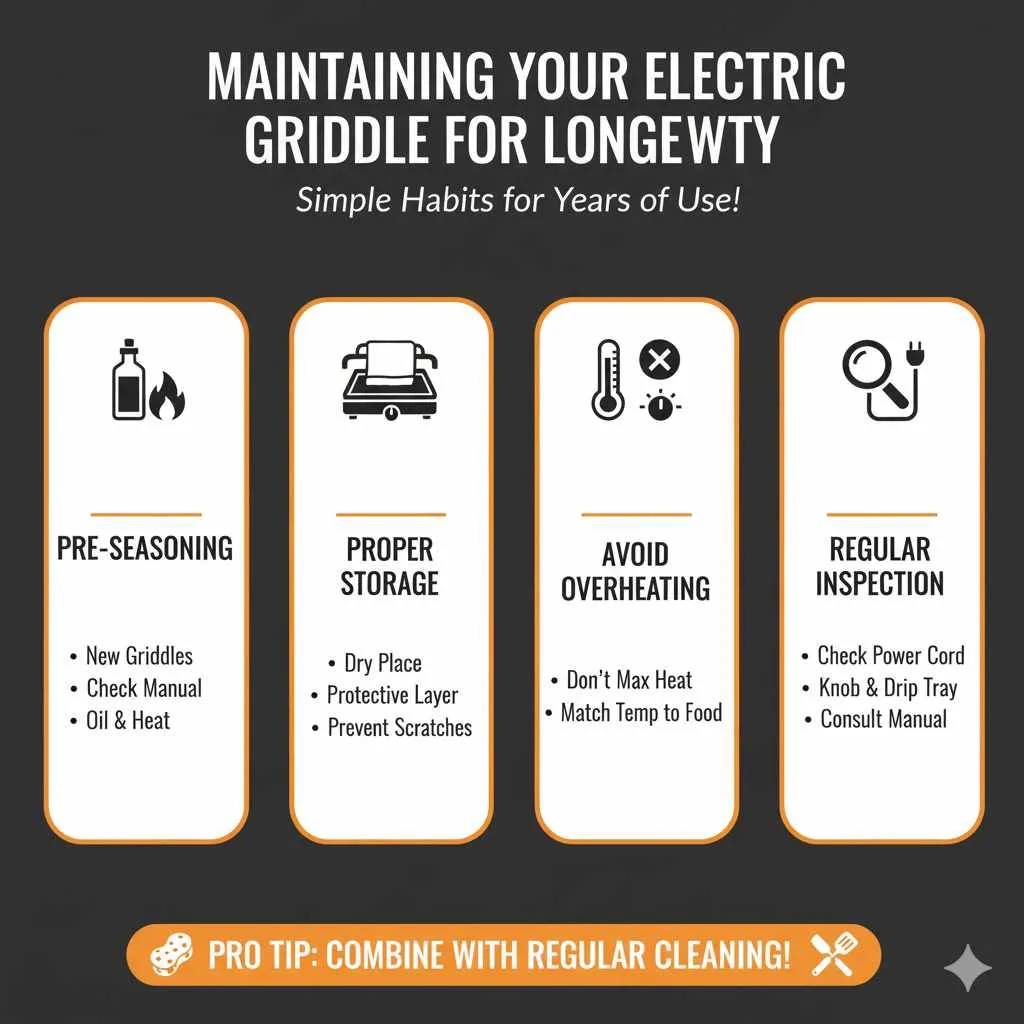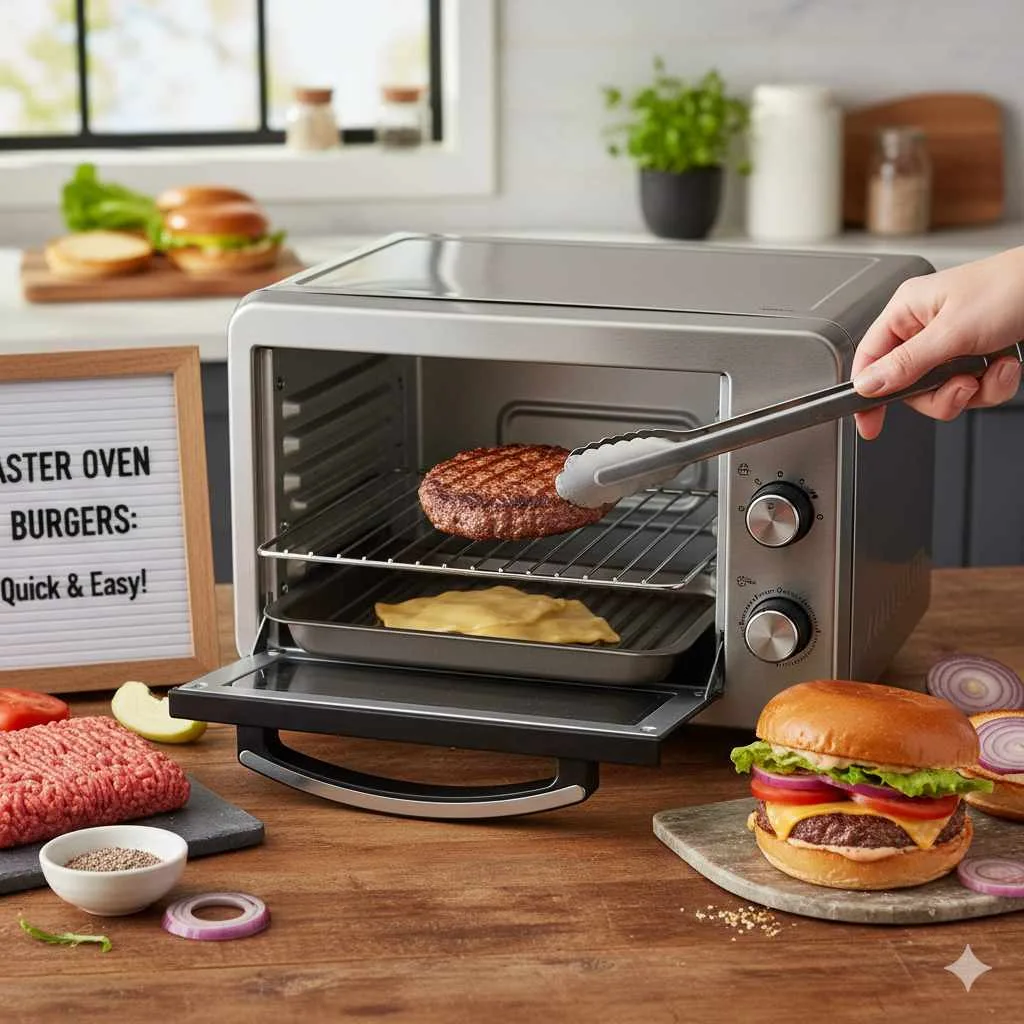To clean an electric griddle effortlessly, unplug it, let it cool, and then use a spatula to gently scrape off food bits. Wipe down with a damp cloth and mild soap for a spotless finish. Avoid harsh abrasives or submerging the unit to maintain its longevity.
Hello! Isn’t it wonderful when your kitchen tools are sparkling clean and ready for your next delicious creation? If you’ve ever looked at your electric griddle after a cooking session and felt a little overwhelmed by the mess, you’re not alone. Those stubborn bits of pancake batter or seared burger residue can seem daunting. But don’t worry, keeping your electric griddle in pristine condition is simpler than you think! With just a few easy steps and the right approach, you can ensure your griddle stays in tip-top shape for countless meals to come. We’ll walk through everything you need to know to make cleaning your electric griddle a breezy, satisfying task.
Why Keeping Your Electric Griddle Clean Matters
Keeping your electric griddle clean isn’t just about appearances; it’s crucial for functionality and longevity. A clean surface ensures even cooking and prevents old food particles from burning onto your fresh meals, altering their taste. It also helps maintain the non-stick coating, which is vital for easy cooking and cleaning in the future. Think of it like maintaining your favorite outfit – with proper care, it looks better and lasts much longer!
Regular cleaning also plays a role in kitchen hygiene, preventing the buildup of grease and food debris that can attract pests or harbor bacteria. For those who love to cook healthy meals, a clean griddle means no unwanted flavors from previous meals to interfere with your latest culinary experiment.
In essence, a little cleaning effort now saves you a lot of hassle and potential problems down the road. It ensures every meal you cook is as delicious and perfect as you intended.

Essential Tools for a Sparkling Electric Griddle
Before we dive into the cleaning process, let’s gather your cleaning arsenal. Having the right tools makes the job so much easier and more effective. You likely have most of these items already in your kitchen:
- Spatula: A flat-edged, heat-resistant spatula (plastic or wood is often best for non-stick surfaces) is your primary tool for scraping.
- Soft Cloths or Sponges: Microfiber cloths work wonderfully for wiping. For tougher spots, a non-abrasive scrub sponge is ideal. Avoid steel wool or harsh scrubbers.
- Dish Soap: A gentle dish soap is perfect for cutting through grease and food residue.
- Paper Towels: Useful for drying and buffing.
- Drip Tray (if applicable): Many electric griddles have a removable drip tray for grease. This needs to be cleaned separately.
- Small Bowl: For mixing warm water and soap.
- Gloves (optional): If you prefer not to get your hands soapy.
Choosing the right tools is the first step to making the cleaning process feel less like a chore and more like a simple maintenance ritual. These items are gentle yet effective, ensuring your griddle remains in excellent condition.
Step-by-Step Guide: How to Clean Your Electric Griddle
Let’s break down the cleaning process into simple, manageable steps. Following these will ensure you get your griddle sparkling clean without damaging its surface.
Step 1: Safety First – Unplug and Cool Down
This is the absolute most important step. Before you do anything else, ensure your electric griddle is unplugged from the power outlet. Then, let it cool down completely. Trying to clean a hot griddle can lead to burns and damage to the griddle surface, especially if it’s non-stick. Patience here is key for both safety and effective cleaning.
Step 2: Scrape Away Loose Debris
Once the griddle is cool to the touch, use your heat-resistant spatula to gently scrape away any large food particles, grease, or crumbs. Work from the edges towards the center. For stubborn bits, you might need to apply a little gentle pressure, but avoid gouging the surface. Most electric griddles have a non-stick coating, so being gentle will preserve it.
A good tip is to angle your spatula slightly to get under those stuck-on pieces without scratching. You want to lift them off rather than scrub them away forcefully at this stage.
Step 3: Wipe Down with a Damp Cloth and Soap
Mix a small amount of mild dish soap with warm water in a bowl. Dip a soft cloth or non-abrasive sponge into the soapy water, wring it out thoroughly so it’s just damp (not dripping wet), and wipe down the entire griddle surface. This will help lift off remaining grease and food residue. You can go over the surface a second time with a cloth rinsed in plain warm water to remove any soap residue.
If your griddle has a removable grease tray, take it out at this stage. Wash it separately in the sink with warm, soapy water. Rinse it well and dry it completely before putting it back.
Step 4: Tackle Stubborn Spots (If Necessary)
For any particularly stubborn, cooked-on spots that didn’t come up with the initial wipe-down, you can try a paste of baking soda and water. Apply the paste to the spot, let it sit for a few minutes (but don’t let it dry completely into a hard crust), and then gently scrub with your non-abrasive sponge or cloth. Afterward, wipe clean with a damp cloth and rinse. Baking soda is a mild abrasive that can help lift tough grime without harming most surfaces. Always test this on an inconspicuous area first if you’re concerned.
Another effective method for tough spots involves heating the griddle slightly again. While still unplugged, you can carefully pour about a cup of warm water onto the griddle surface. This can help loosen stuck-on food. Let it sit for a minute, and then try scraping again with your spatula.
Step 5: Dry and Polish
After cleaning, use a dry, soft cloth or paper towels to thoroughly dry the entire griddle surface. This prevents water spots and streaks, and also helps protect the non-stick coating. A quick buff with a dry microfiber cloth can leave your griddle looking beautifully clean and ready for its next use.
When to Use Different Cleaning Techniques
Not all messes are created equal, and sometimes a simple wipe-down isn’t enough. Understanding when to use different cleaning techniques can save you time and effort.
For Light Messes (e.g., crumbs, light residue):
- Simply unplug, let cool, and wipe with a damp cloth.
- Use a dry cloth to buff.
For Moderate Messes (e.g., pancake batter, light grease):
- Unplug, cool, and scrape with a spatula.
- Use a damp cloth with mild dish soap and warm water.
- Rinse with a clean, damp cloth.
- Dry and buff.
For Heavy Messes (e.g., burnt-on food, thick grease):
- Unplug, cool, and scrape with a spatula.
- Try the baking soda paste method or a warm water soak (as described in Step 4).
- Use a non-abrasive scrub sponge for gently scrubbing the stubborn spots.
- Thoroughly clean with soapy water, rinse, and dry.
- Don’t forget to clean the removable drip tray thoroughly.
It’s always best to start with the gentlest method and only move to more intensive techniques if necessary. This preserves the integrity of your griddle’s cooking surface.
What to AVOID When Cleaning Your Electric Griddle
Just as important as knowing what to do is knowing what not to do. Certain cleaning methods can permanently damage your electric griddle. Here are a few things to steer clear of:
- Submerging the Griddle: Never immerse the main body of the electric griddle in water or any other liquid. The electrical components are not waterproof and can be severely damaged, creating a safety hazard.
- Harsh Abrasives: Avoid steel wool, abrasive scouring pads, or harsh chemical cleaners like oven cleaner. These will scratch and strip the non-stick coating, rendering your griddle less effective and harder to clean in the future.
- Metal Utensils for Scraping: While a spatula is useful, avoid using sharp metal knives or forks to scrape. These can easily scratch the surface. Stick to plastic, silicone, or wood spatulas.
- Dishwasher: Unless your griddle specifically states it is dishwasher safe (which is very rare for the main unit), do not put it in the dishwasher. Same reasons as submerging – electrical components and potential damage to the cooking surface.
- Extreme Temperature Changes: Do not plunge a hot griddle into cold water. This rapid temperature change can warp the metal and damage the non-stick coating. Always let it cool down.
Avoiding these common mistakes will significantly extend the life and performance of your electric griddle, ensuring many more delicious meals to come. Think of it as protecting a valuable kitchen asset!
Tips for Specific Griddle Surfaces
While most electric griddles share common cleaning principles, some surfaces might require slightly different approaches. Here’s a quick look:
Non-Stick Coated Griddles
These are the most common type. The key here is to be gentle. Always use soft cloths, non-abrasive sponges, and plastic or silicone spatulas. Avoid harsh chemicals and abrasive scrubbers to protect the coating. Follow the step-by-step guide above meticulously.
Cast Iron Griddles (Less Common as Electric Units)
If you have an electric griddle with a seasoned cast iron surface, the cleaning is different. You’ll typically clean it similarly to a traditional cast iron pan: scrape off food, wipe with a damp cloth, and then lightly coat with cooking oil to prevent rust. Never use soap as it can strip the seasoning. However, most electric griddles are not cast iron, so confirm your griddle’s material.
Stainless Steel Griddles
Less common for electric griddles, but if yours is stainless steel, you can be a bit more vigorous. A non-abrasive pad is usually safe. For tougher baked-on food, you can use a paste of baking soda and water, or even a dedicated stainless steel cleaner, ensuring you always rub in the direction of the metal grain. Always rinse thoroughly and dry to prevent water spots.
Knowing your griddle’s surface material is half the battle in cleaning it correctly. Always refer to your griddle’s owner’s manual for manufacturer-specific cleaning instructions if you’re unsure.
Maintaining Your Electric Griddle for Longevity
Cleaning is an essential part of maintenance, but a few extra habits can ensure your electric griddle serves you for years to come. Proper care goes beyond just wiping it down after each use.
Pre-Seasoning (New Griddles)
Some new griddles may benefit from a light seasoning before their first use, similar to cast iron. Check your manual. This often involves wiping with oil and heating it. This step can help build up the non-stick properties and protect the surface.
Proper Storage
When not in use, store your griddle in a dry place. If you stack other items on top, place a protective layer, like a clean towel or a piece of cardboard, over the griddle surface to prevent scratches.
Avoid Overheating
Don’t preheat your griddle on the highest setting for excessively long periods if you aren’t cooking. This can degrade the non-stick coating over time. Use the heat setting appropriate for the food you’re cooking.
Regular Inspection
Periodically check the power cord for any signs of fraying or damage. Ensure the temperature control knob turns smoothly and the drip tray fits securely. If you notice any issues, consult your owner’s manual or the manufacturer.
These simple maintenance tips, combined with diligent cleaning, will keep your electric griddle performing at its best and looking great.

Frequently Asked Questions About Cleaning Electric Griddles
Q1: Can I use cooking spray on my electric griddle?
A1: For most non-stick electric griddles, it’s best to avoid cooking sprays. The propellants and emulsifiers in sprays can build up a sticky residue over time that is difficult to remove and can damage the non-stick coating. Using a small amount of oil or butter directly on the griddle is generally recommended.
Q2: How often should I deep clean my electric griddle?
A2: It’s a good practice to give your electric griddle a thorough cleaning (following the step-by-step guide) after each use. A “deep clean” or more intensive cleaning for stubborn spots is typically only needed when you notice significant buildup or burnt-on food that a regular wipe-down won’t address.
Q3: My griddle has a non-stick coating that’s starting to peel. What should I do?
A3: If the non-stick coating is peeling, it may be a sign of wear and tear or damage from improper cleaning. Unfortunately, once the coating is compromised, it’s difficult to repair. You might need to consider replacing the griddle. For prevention, always use non-abrasive cleaning methods and avoid metal utensils.
Q4: Is it okay to use a grill brush on my electric griddle?
A4: No, a grill brush with stiff metal bristles is too abrasive for most electric griddle surfaces, especially those with non-stick coatings. It will scratch and damage the surface. Always opt for softer tools like plastic spatulas and non-abrasive sponges.
Q5: How do I clean the outside of my electric griddle?
A5: For the exterior housing and handles, unplug the griddle and let it cool. Wipe down with a damp cloth and mild dish soap. For tougher spots on plastic or metal casings, you can use a gentle all-purpose cleaner. Ensure no liquid seeps into vents or electrical components. Always dry thoroughly.
Q6: Can I use vinegar to clean my electric griddle?
A6: While diluted vinegar can be effective for descaling in some appliances, it’s generally not recommended for cleaning the cooking surface of most electric griddles, especially non-stick ones. Its acidity can potentially damage some coatings. Mild soap and water or baking soda paste are safer and more effective options for general cleaning. If your manual specifically recommends vinegar for a particular purpose, follow that guidance.
Q7: What’s the best way to remove burnt-on grease?
A7: For burnt-on grease, unplug the griddle and let it cool. You can try making a paste of baking soda and a little water, applying it to the burnt areas, and letting it sit for 10-15 minutes before gently scrubbing with a non-abrasive sponge. Alternatively, pour a small amount of warm water onto the cool griddle, let it sit for a few minutes to loosen the grime, then carefully scrape with a plastic spatula. Always wipe clean and dry thoroughly.
Conclusion
And there you have it! Keeping your electric griddle sparkling clean and ready for its next culinary adventure is a straightforward process when you know the right techniques. By remembering to prioritize safety, use gentle cleaning tools, and avoid harsh methods, you’ll not only maintain your griddle’s performance but also extend its lifespan significantly. A clean griddle means better-tasting food, a more hygienic kitchen, and the pure satisfaction of a job well done.
So, next time you finish cooking up a storm, don’t dread the cleanup. With these effortless pro tips, cleaning your electric griddle will become a quick, simple, and even enjoyable part of your cooking routine. Happy cooking, and enjoy those perfectly cleaned surfaces for many delicious meals to come!








Leave a Reply